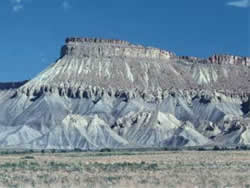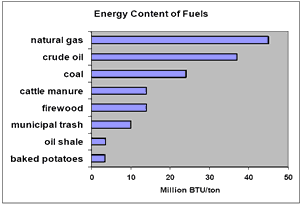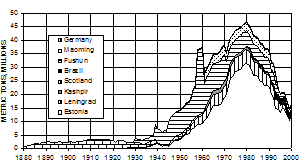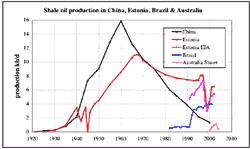|
Whether we drive a gas guzzler or a gas miser, we will all be affected by coming oil shortages. So what's a lover of today's petroleum-based global economy to do? Will some other energy source make it possible to keep wantonly pulling up to the pumps forever and ever?
 One seemingly attractive solution to future energy woes is oil shale. There is a LOT of the stuff—especially in the US West (mostly Utah and Colorado)—so if we can just figure out how to turn it into oil efficiently, we'll be set for quite a while.
One seemingly attractive solution to future energy woes is oil shale. There is a LOT of the stuff—especially in the US West (mostly Utah and Colorado)—so if we can just figure out how to turn it into oil efficiently, we'll be set for quite a while.
Oh, if it were only that easy. Lest we have any silly ideas that oil shale will be a quick fix to our oil shortages, today's guest article will knock those notions right out of our noggins. It's from Randy Udall and Steve Andrews, two of the founders of
ASPO-USA, the US affiliate of the Association for the Study of Peak Oil and Gas.
~ ~ ~
The Illusive Bonanza: Oil Shale in the U.S. —
“Pulling the Sword from the Stone”
by Randy Udall and Steve Andrews, ASPO-USA
Oil Shale — A History of Hope
Buried beneath the ground in Colorado and Utah are a trillion tons of oil shale. Throughout the 20th century, men have tried and tried again to unlock the energy contained in these rocks. To date, all efforts have failed. But every twenty or thirty years, when energy prices spike, a new attempt is mounted.
The persistence is understandable—whoever unlocks this resource would capture a trillion dollar prize. But oil shale's track record is not encouraging. The rocks are stubborn—an illusive bonanza, promising much and delivering little. Despite a century of trying and $10 billion in investment, oil shale currently provides an infinitesimal 0.01% (or one ten-thousandth) of world energy.
This paper explains why oil shale is so difficult to unlock, and why the "rock that burns" may never provide more than 1% of US energy.
Oil Shale and Never-Never Land
In 2005, after oil prices doubled to $60 per barrel, the US Department of Energy published a new report on oil shale's promise. Sections of the report seem delirious, as if the authors were determined to illustrate that anything is possible on paper. In particular, the study claimed that we could wring "200,000 barrels a day from oil shale by 2011, 2 million barrels a day by 2020, and ultimately 10 million barrels a day." These predictions—both the production targets and their timing—are preposterous, as some industry experts admit.
Hyping oil shale is nothing new. As geologist Walter Youngquist once wrote, "Bankers won't invest a dime in 'organic marlstone,' the shale's proper name, but 'oil shale' is another matter."
Oil shale's history is one of delusions leading to disappointments. Sometimes the delusions have been motivated by a stock scam, but mostly they seem to have been driven by a belief that wishing can make it so. Peter Pan would have loved the oil shale industry.
Oil Shale — Hard Black Gold?
After hearing the bullish projections for oil shale so often, politicians are perplexed by the lack of progress. "I find it disturbing that Utah imports oil from Canadian tar sands, even though our oil shale resource remains undeveloped," says Utah Senator Orrin Hatch.
It's a maddening paradox. If oil shale really is "the richest fossil fuel resource on earth," why has no nation ever produced more than 16,000 barrels a day? And if there really are "one trillion barrels of hard, black gold" in the world's shale ores, why is global production declining? It's as if we are standing in front of a treasure vault, fumbling with the key.
Sixty percent of the world's oil shale is in Colorado and Utah—we know exactly where it is—and yet those states produce no oil from shale. Meanwhile, Alberta is producing one million barrels per day of oil from its tar sands. Are Americans dumber than Canadians?
Energy Density — Oil Shale and Dung Cakes
Oil shale has many apologists. They suggest that technology is lacking. They suggest that cheap oil is to blame. Ever confident, they suggest that "its day will come, just wait." Yet the day never comes. Why has oil shale failed to deliver?
The primary explanation is that oil shale is a very poor fuel. Compared to the coal that launched the Industrial Revolution or the oil that currently sustains Western Civilization, oil shale is a pathetic pretender—the dregs of the energy cask.
When it comes to energy, quality is everything. Quality can be measured in various ways—cost, convenience, and cleanliness all matter—but energy density trumps them all. Coal seams a few feet thick are worth mining—sometimes at depths exceeding 1,000 feet—because coal contains lots of energy.
Dense forms of energy like coal and crude oil invented prosperity; they are industrial oxygen. If coal is good, oil is better. Petroleum contains 50% more energy than the best coal, twice that of the hardest oak.
 There's a lot of "grunt" in a gallon of gasoline—enough to propel a 3,000 pound car thirty miles.
There's a lot of "grunt" in a gallon of gasoline—enough to propel a 3,000 pound car thirty miles.
If crude oil is king, oil shale is a pauper. Pound per pound, oil shale contains just one-tenth the energy of crude oil, one-sixth that of coal, and one-fourth that of recycled phone books. Shale outcrops are common in Colorado, but in prehistoric times the Utes did not use oil shale for heat. Why bother when you could gather pine or juniper instead?
In poor countries, millions of people heat their homes with dried manure. Dung cakes have four times more energy than does oil shale.
Oil shale is a fossil fuel—but just barely. Oil shale is said to be "rich" when one ton of it contains 30 gallons of petroleum—less than one barrel. Searching for appropriate low-calorie analogues, we must turn to foodstuffs, the realm of Weight Watchers. An equal weight of granola contains three times more energy than oil shale.
The "vast," "immense," "unrivaled" deposits of oil shale buried in Utah and Colorado have the energy density of a baked potato. If someone told you there were a trillion tons of tater tots buried 1,000 feet-deep, would you rush to dig them up? Take a memo, Senator—oil shale has one-third the energy density of Cap'n Crunch. But no one is counting on Kellogg to become a major energy producer soon. No one is proposing drilling in the cereal aisle.
The mystery is not that we lack an oil shale industry, it's why we've spent billions trying to develop one.
The Formation of Oil Shale — A Ten-Million-Year Rain
According to the US Geological Survey, half of the planet's oil shale lies within 150 miles of Grand Junction, Colorado. The shale is contained in the Green River Formation, which is famous for its wonderful fossils—imprints of sycamore leaves, dragonflies, extinct birds, crocodiles, and strange fish that lived in the area's ancient lakes. The thick layers of shale were created by a million-year drizzle of fine clay and dying algae. The energy in oil shale is essentially preserved pond scum.
The term "oil shale" is a misnomer. The rock is a marlstone, and the hydrocarbon is a waxy molecule called kerogen. Kerogen is a proto-petroleum—oil and gas are generated when kerogen is exposed to heat deep in the Earth's oven. If the Green River Formation had been buried deeper, time would have cooked the kerogen into petroleum. But since it wasn't buried deeper, to extract energy from these rocks, you have to "put them back in the oven" and supply the heat Nature failed to furnish during fifty million years of geologic time.
Oil Shale Production Around the World
As a rule, nations don't tap oil shale unless they are destitute. The world's primary producer has been Estonia, a Baltic nation lacking in coal, natural gas, oil, or hydropower resources.
 When Russian natural gas and nuclear power became available, Estonia began to phase out its shale oil industry.
When Russian natural gas and nuclear power became available, Estonia began to phase out its shale oil industry.
Elsewhere, small amounts of shale have been mined in China, Brazil, and Russia. (See graph. Click image to see larger version of graph; or click here.) Most recently, a well-funded and much-ballyhooed Australian oil shale experiment failed. Tellingly, one partner in that bankrupt project was Suncor, a successful developer of the Canadian tar sands. After losing $100 million, Suncor now appreciates the critical distinctions between tar sands and oil shale.
There are two ways to produce shale oil. Typically, the rock is mined like coal. After being loaded and trucked to a processing plant, the shale is crushed and fed into an enormous kiln (or "retort"), where it is roasted to 1,000 degrees F. The heat "cracks" the kerogen, whose distilled vapors can be refined into a liquid fuel. Retorting oil shale is capital-intensive, messy, inefficient, and polluting. It consumes lots of energy and water. The slag, swollen in volume and contaminated with arsenic, must be safely disposed of. The entire process is so costly and laborious that global production has never exceeded 25,000 barrels a day, compared to today's 84 million barrels of global daily oil production.
Retorting a million barrels of shale oil each day, as some propose, would entail mining 700 million tons of shale per year, disposing of an equivalent amount of mining waste, digging the world's deepest open pit mines, constructing a hundred retorts, and platting new cities to house tens of thousands of workers. In sum, it would be the largest mining operation in the world.
Oil Shale in the U.S.
In 1912, President Taft established the Naval Petroleum and Oil Shale Reserve. In the century since, a dozen attempts to commercialize the resource have failed.
|
The big push came in the 1970s, after the Arab Oil Embargo. Despite federal price supports of $40 per barrel and $10 billion in investment, the mammoth effort failed. In a 13-year period, only five million barrels were produced—as much oil as the US now consumes every six hours. When oil prices collapsed, Exxon, Tosco, and Unocal left. Shell threw in the towel, too, but it held onto the property it had purchased back in the 1950s.
|
 |
|
Global production of oil shale was about 11,000 barrels/day in 2000. This represents less than 0.01% or one ten-thousandth of global energy.
(Click to see larger version.)
SOURCE: Petroleum geologist Jean Laherrere, from "Oil Shale Review."
|
|
By 1990, Shell's scientists had concluded that blasting, digging, hauling, roasting, disposing and revegetating millions of tons of shale ore would never be economically viable or environmentally acceptable. But it was hard for the company to completely turn its back. In the last 150, years humans have burned about one trillion barrels of conventional oil. The second trillion barrels will be consumed in the next thirty years. Given the burgeoning demand for transportation fuels, Shell wondered if there was another way to "pull the sword from the stone." Instead of bringing the rock to the heat, what if you brought the heat to the rock?
Shell's Shale Oil Extraction Method —
Pulling the Sword from the Stone?
Although it remains one of the world's great energy companies and is currently reaping record profits, Shell has been challenged in recent years. An accounting scandal forced it to restate its reserves. Hurricane Katrina hammered one of its deepwater production platforms in the Gulf of Mexico. The company also missed out on western Colorado's lucrative natural gas play, where production is now equivalent to 100,000 barrels of oil per day. With Muslim nations holding most of the world's remaining oil, Shell is finding it difficult to replace its reserves.
|
But if Shell could "pick the lock" on the oil shale vault, an exciting and profitable new chapter of its history would be assured. To this end, the company has spent tens of millions of dollars investigating whether oil shale can be heated underground. Until recently, Shell's employees have been careful not to hype their own research; it's just R&D, they insist. The caution is understandable, since most of the techniques are experimental. But the new methods are promising enough that the company recently submitted the largest patent application in the history of the US Patent Office.
Although Shell's plan is fresh and bold and audacious, some aspects of it seem inspired by Star Trek. Time will tell whether the company's "in-situ" process is madness or genius. The vision is breathtaking. The company proposes to electrically heat a 1,000 foot-thick section of the Green River Formation to 700 degrees Fahrenheit, then keep it that hot for three years.
Beam me up, Scotty. But first, some details.
|
|
Shell's Approach and Electricity Demand |
|
Shell's Mahogany Research Facility is near Rangely, Colorado. As of 2005, the company has produced some 2,000 barrels of oil shale from a test plot the size of a three-car garage. Shell now plans to test key aspects of its method, including the frost wall and down-hole heaters, at a larger scale. Results will be available in 2009. Spokesmen say they expect to harvest about 65% of the oil in place, two-thirds as a liquid, the remainder natural gas.
According to the RAND Corporation, "An operation producing 100,000 barrels per day requires approximately 1.2 gigawatts of dedicated generating capacity." This is a very large power plant, equivalent to the capacity of Colorado's largest existing power plant. It follows that production of a million barrels a day would require ten such power plants, plus five new coal mines to feed them.
Shell believes it can harvest 3.5 units of energy for every unit of electricity consumed. But this presumes the electricity is produced at a 60% efficient power plant. A standard new coal plant has efficiency in the 35% range, reducing the "net energy" balance to 2:1. Shell has not released detailed studies of this critical issue, but we suspect the real energy return may be even lower.
At this early stage, one can only guess at Shell's initial capital cost for producing 100,000 barrels per day. Including the necessary power plant, our guess is that it would be in the $7 billion to $10 billion range.
|
|
Imagine a hundred-acre production plot, 2,000 feet on a side. Inside that area, Shell would drill up to 1,200 closely spaced wells. After those wells are lined with steel casings, 1,000-foot-long electric heaters would be inserted in preparation for "the bake."
But before the fire comes the ice. Since it's impractical to heat the rock if it's in contact with groundwater, Shell has to dewater the production area first. To do that, it proposes to construct a "frost wall" to isolate the production zone from the surrounding area. (Frost walls are routinely used in skyscraper foundations, but of course few foundations are 2,000 feet deep.) To build the frost wall, the company will drill a narrowly spaced line of wells, case them, then circulate a frigid coolant until the rock freezes solid. If the frost wall holds, the company will drill dewatering wells inside the production zone. Once the shale is dry, it will be heated, and if all goes well, three years later oil and natural gas will flow.
The company hopes to recover up to one million barrels per acre—$60 million worth at today's prices. It's a high-stakes gamble, but if it works, a six-mile-by-six-mile area could produce twenty billion barrels—roughly equal to the remaining reserves in the Lower 48 states.
Although Shell's method avoids many of the negative impacts of mining oil shale, it requires a mind-boggling amount of electricity. To produce 100,000 barrels a day would require raising the temperature of 700 billion pounds of shale by 700 degrees F. How much power would be needed? A gigabunch. In rough numbers, about $500,000,000 worth per year.
The least expensive source for electricity is a coal-fired power plant. To produce 100,000 barrels of shale oil per day, the RAND Corporation recently estimated that Shell will need to construct the largest power plant in Colorado history—large enough to serve a city of 500,000. This power plant, costing about $3 billion, would consume five million tons of coal each year, producing ten million tons of greenhouse gases, some of which would still be in the atmosphere a century from now. To double production, you'd need two power plants. One million barrels a day would require ten new power plants and five new coal mines.
How soon will we know whether any of this is feasible? Shell plans to do more experiments before making a go/no-go decision by 2010. If the company pulls the trigger, it would be at least three or four years before first oil would flow, perhaps at a rate of 10,000 barrels a day. That's less than one-tenth of one percent of current US consumption.
The Outlook for Oil Shale
What contribution can oil shale make to energy security? Producing 100,000 barrels per day of shale oil does not violate the laws of physics, and if the price of conventional crude rises high enough, it might be economical to do so. But the US is currently consuming 100,000 barrels of oil every seven minutes. Increasing the efficiency of America's automobiles by two miles per gallon would save ten times as much fuel each year, saving consumers $100 billion at the pump. The National Academy of Sciences has stated that bolder efficiency targets—cars, trucks, and SUVs getting 30, 40 or 50 miles per gallon—are achievable and affordable.
An aggressive national commitment to fuel efficiency is not optional, it's inevitable. In time, a more efficient fleet could save 20 times as much petroleum as oil shale will ever provide.
Oil shale is not a silver bullet, and it will not delay the imminent peak of world oil production. It will not reduce global oil prices. It will do little to enhance US energy security. By 2020, oil shale might yield 100,000 barrels a day, but that remains uncertain.
Finally, we mustn't forget about "net energy." If it turns out that Shell needs more energy to produce a barrel of oil from shale than the resulting barrel of oil contains, all bets are off. That would be a fool's bargain. Electricity is energy its most valuable form, and using coal-fired electricity to wring oil out of rocks would be like feeding steak to the dog and eating his Alpo.
Americans love panaceas. We want thinner thighs in thirty days, a pill to cure baldness, an ultrasonic carburetor that will double our mileage. For a century, promoters have pitched oil shale as a path to riches and energy independence. A magic wand would indeed be nice, because the nation faces serious energy challenges. Because domestic oil production peaked more than 30 years ago, the need for energy efficiency, conservation, and renewable energy is both obvious and urgent.
Wrap-Up
As global population and Chinese oil demand grow, new energy sources will be avidly sought. Making intelligent choices about what energy paths to pursue is critical.
|
Yes, there's lots of low-grade oil shale in Colorado and Utah. But there's also enough microscopic gold in the ocean to make everyone rich and enough Helium 3 on the moon to power the world for thousands of years. Fusion reactors have been just around the corner for fifty years, and we may be able to one day harvest the Northern Lights or transmit wind energy from the Aleutians to Atlanta. Grandiose schemes to meet the world's energy needs always find articulate proponents.
|
|
Energy to Make Pigs Fly |
|
It is theoretically possible to microwave solar energy to Earth from outer space. "Helium 3 could be the cash crop for the moon," says Gerald Kulcinski, Director of the Fusion Technology Institute (FTI). "When the moon becomes an independent country, it will have something to trade." And when pigs have wings, they may fly.
|
|
Dreams and hype aside, oil shale is the poorest of the fossil fuels, containing far less energy than crude oil, much less even than hog manure, peat moss, corn pellets, household garbage, or Cap'n Crunch. Containing such a meager amount of energy tightly bound up in an enormous volume of rock, oil shale seems destined to remain an illusive bonanza, the petroleum equivalent of fool's gold.
Further Reading
Oil Shale Development in the United States
(PDF; RAND Corporation report) (Item no longer available from host site.)
Shale Oil—The Elusive Energy
(PDF; Walter Youngquist paper)
About The Authors:
Randy Udall directs the Community Office for Resource Efficiency in Aspen, Colorado. Their address is PO Box 9707, Aspen, Colorado. Randy can be reached at 970-963-5657 or rudall@aol.com.
Steve Andrews is a Denver-based energy analyst and now directs ASPO-USA, a non-profit, non-partisan research and public education initiative to address America's peak-energy challenge. Visit them at www.aspo-usa.com. Steve can be reached at 303-759-1998; or P.O. Box 1429, Westcliffe CO 81252; or sbandrews@att.net.
|
|
Know someone who would get pumped up over this Oil Shale article?
Please send it to them.
Related articles:
THE CONQUERING FORCE PLANTED THE FLAG ON THE OIL PEAK
Oil Wars or Adaptation
THE THREE LAWS OF OUR ENERGY PEAK FUTURE: LOCAL, LOCAL, LOCAL
Energy Peak and Relocalization
More articles and resources on....
Get Grinning Planet free via email
|


